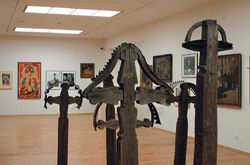Naďa Kančevová
The self perception of individual nations (including the Slovak one) is woven with myths, and it seems that critical reflection (de-myth) is currently one of the main topics of social and scientific disciplines. Therefore, one might hold the impression that the Slovak Myths exhibition is within the framework of these topical de-myth tendencies. The curator’s intention, however, proves otherwise since the exhibition does not place the myth into the position of something that must be eliminated with scientific explanation but rather presents it as “fertile soil” for the culture and basis for artistic initiatives.
One of the important concepts of the exhibition used ideas formulated by the French philosopher Paul Ricoeur. The quotation from his work appeared at the same time as the starting point when entering the exhibitions. Ricouer wrote: “An important process rather than de-mything is to acquire the hidden symbolism of the richness… we are never finished with destroying idols in order to have symbols to talk about.”
It could be said that it is the function of myth accented by Ricoeur that offers a thought platform on which we need to perceive (“read”) the exhibition. If the newer historical and cultural interpretations mainly appeal to the dangers that the power of myths hides, the exhibition (and accompanying publication) focused on another aspect – searching for symbols or “visual archetypes of Slovakness”.
The exhibition’s curators do not doubt that this specificity (“Slovakness”) in painting art of the twentieth (but also the twenty-first) century exists. The exhibition was born precisely because of this belief. Using relatively vast and quite diversified material, it strove to offer visitors the opportunity to create their own definition of Slovakness as reflected in painting arts.
At the same time it needs to be emphasized that it is the diversity of the exhibited materials which is news in Slovak conditions. Apart from more or less known works of Slovak Modern representatives, visitors encounter naïve art and utilitarian works, text documents and public records. From the point of view of current exhibition practises, it is also stimulating that the exhibited material is all presented as equal and therefore does not distinguish between so-called “high” and “low” art.
